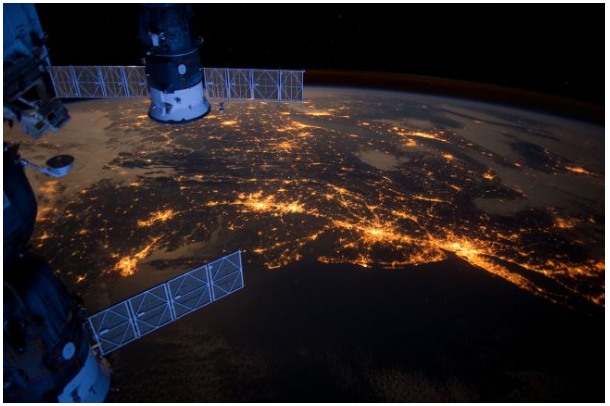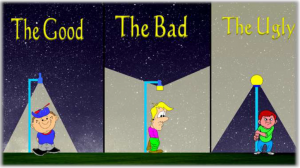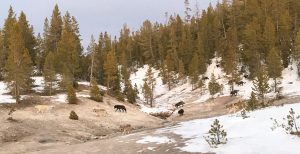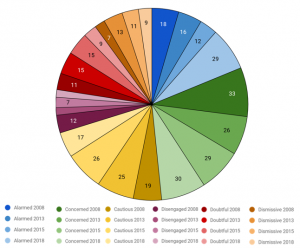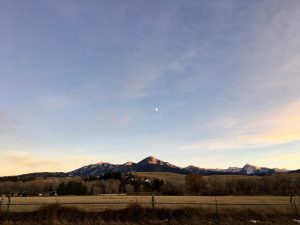By Rachel Dodgen
My dad is a huge nerd and loves everything space. He often spends his nights watching reruns of Star Trek, dreaming of captaining the Enterprise and making the same jokes about the guy in the red shirt. The best part about having a nerdy space dad (besides that he passed his nerdiness onto me) is that he was always on top of the coolest cosmic events happening. Anytime there was a meteor shower or some planet would be visible, we were outside staring up into the sky trying to decipher exactly what we were seeing. But, we never could quite make it out. It wasn’t until I moved from the Carolinas to Yellowstone National Park and began working on their Dark Sky initiative that I realized why.
My first weekend residing in Yellowstone I spent exploring as much as possible with my parents in tow. This included waking up at four in the morning to drive out to Lamar Valley in hopes of seeing a wolf. As we arrived in the valley, my dad and I stepped out of the car (my mom too afraid of the cold to even attempt it) into the near pitch black hoping for some wildlife. I was busy squinting into the valley when I looked over and saw my dad staring straight up. I followed suit and, for lack of a better term, holy guacamole! The entire Milky Way was visible! I had never seen such a beautiful sky and I don’t think my dad had since he was a young boy. He won’t admit it, but I’m pretty sure he shed a tear. It was then that I truly realized what I, and the majority of the United States population, have been missing out on my whole life. I just never realized that I could see the Milky Way with my own two eyes. I grew up in an area where the lights never go out, now true for 1/3 of the human population, and these lights prevented me from seeing more than a few dozen stars in the sky at once.
In my first month serving at Yellowstone, I have dived head first into the Dark Sky world, especially with my new-found appreciation, learning all I could about light pollution and its solutions. My goal is to prepare Yellowstone’s lighting inventory, so we can submit the Dark Sky Park application, but also to spread awareness to local communities and any area where the cosmos are visible about how lucky they are and how precious this resource is and in need of protection.
Here’s a quick(ish) guide to appropriate Dark Sky-friendly lighting:
- Use fully shielded fixtures which completely cut off vertical and horizontal light shine. Vertical shine scatters into the sky reducing cosmic visibility, and horizontal shine causes glare and light intrusion. Fully shielded fixtures also direct the light where it’s intended to go so oftentimes you can install a lower wattage light, saving energy.
- Install yellow-colored bulbs (less than 3000 Kelvin) as opposed to more blue/white bulbs for night fixtures. We have a special light sensitive protein, melanopsin, in our eyes that is not used for seeing but for regulating our sleep cycle. When melanopsin does not detect light it signals our brain to produce melatonin which makes you sleepy. Melanopsin is most sensitive to blue light (like what we are always warned about while staring at computers and phones all day), which it reads as daylight and tells you to be awake, disrupting your sleep cycle and can lead to anxiety. Artificial blue light also affects animal and plant behavior similarly, disrupting nocturnal processes.
- Brighter is not better. Security is not safety. You can seldom step outside at night without a street lamp or sign lighting your way, but this absence of exposure to the dark has given us a false sense of security in ultra-bright lighting. Even though you may feel secure under the brightest lights at night, these lights actually prohibit the eye from being able to see past the lit area and into the darkness since our eyes work by contrast. You cannot see what’s out there, therefore your safety is compromised (a big issue in places like Yellowstone where wildlife is just outside your door).
- Use motion sensors and LEDs for the most efficient night lighting. LEDs are the most efficient lightbulbs available using 75% less energy and lasting 25 times longer than incandescent bulbs. They are steadily reducing in price, constantly improving technologically, and come in every color imaginable. Smart lighting has also grown exponentially in the last several years and is a great way to reduce energy use and tune the color of your bulbs, but using simple timers is a great financially friendly way to schedule your lights for when you need them.
- Eliminate unnecessary lighting and turn off lights at night. Walking around a town or city there is an abundance of lights — lights less than five feet apart down the street, lights above lights on buildings, lights pointed at already lit signs. Identifying and removing these lights reduces pollution and saves electricity, an easy no brainer!
To summarize:
I didn’t grow up with a proper night sky and neither did 80% of Americans — clearly shown in the picture taken from the International Space Station of the East Coast cities lighting the atmosphere. Some areas, mainly parks and small towns, are taking action against excessive lighting but the main trend has been brighter and more lighting as population grows with no one really offering an opposition. Light pollution is rarely discussed in conservation efforts because so many Americans simply haven’t experienced a truly Dark Sky, we are accustomed to and feel secure in our well-lit society, and we don’t realize the effects a 24/7 lit world is having on our health and the planet’s health. And in a world of complex problems and issues facing the planet, environment, and future generations this may be the easiest to fix — just flip the switch.
Also side note: I can’t believe I live in Yellowstone National Park and am getting to experience the most amazing things on a regular basis. I have juvenile elk frolicking in the snow on my front lawn, watched a coyote hunt for voles in the snow where they do the cute pounce-dive, and saw the biggest pack of wolves just on the side of the road (the picture doesn’t do it justice)! I am just in shock and am still waiting to wake up from this dream it is so unreal. Truly the experience of a lifetime.

